
Chapter 11: Cell Growth and Division >
11.1 Cell Growth, Division, and Reproduction
An organism grows not because its cells increase in size, but because its cells grow and divide. Two reasons for this are that larger cells are less efficient in moving nutrients/waste materials and require more DNA.

Imagine if these cubes were cells. As the cells grow larger, the volume (amount of space in the object) grows more than the surface area (amount of "covering" on the object), which is an issue because the decrease of the relative cell membrane can create problems.

If a cell gets too large, it would be harder for it to get oxygen/nutrients in, and waste products out, similar to a traffic jam. The cell would also get bigger while its DNA stays the same, meaning that its DNA may not be sufficient (information overload: the larger the cell, the more demands it places on its DNA).
Therefore, it is better to split into two cells and duplicate the DNA so that both of the new cells can use them. This is called cell division, a process in which a cell is divided into two, and the DNA is replicated or divided. The problem of information overload is solved, and cell volume is also reduced, making the cells more efficient in the transportation of materials. Cell division is also asexual reproduction, which is the only form of reproduction for many single-celled organisms.
Asexual Reproduction: The production of genetically identical offspring from a single parent
Pros-
✩Quick reproduction if conditions are right, which is good for competition
✩More offspring in a short period
✩No need for another mate
Con-
✩Lacks genetic diversity, and cannot adapt to unfit conditions

Sexual Reproduction: The fusion of two reproductive cells formed by each of the two parents. Offspring produced by sexual reproduction inherit some of their genetic information from each parent
(most plants and animals reproduce this way, as well as many single-celled organisms).
Pros-
✩Advantage to species with changing environments or seasons: species can adapt by ensuring that a population contains the right characteristics to boost survivability.
Cons-
✩Requires more time
✩Needs to find a mate 
11.2 The Process of Cell Division
Cell division is constantly occurring in living beings, even when we stop growing. Whether you get a cut or fracture a bone, cell division keeps us in good condition by replacing worn cells and regenerating lost tissue.
A cell cannot simply split into two without preparation, especially because the genetic information needs two copies before cell division starts.
Cells have plenty of genetic information in the form of DNA carried by chromosomes, which is a structure within the nucleus.
In prokaryotic cells, DNA is packaged into a single, circular chromosome. In eukaryotic cells, DNA is packaged into multiple chromosomes and is more complex with multiple components.
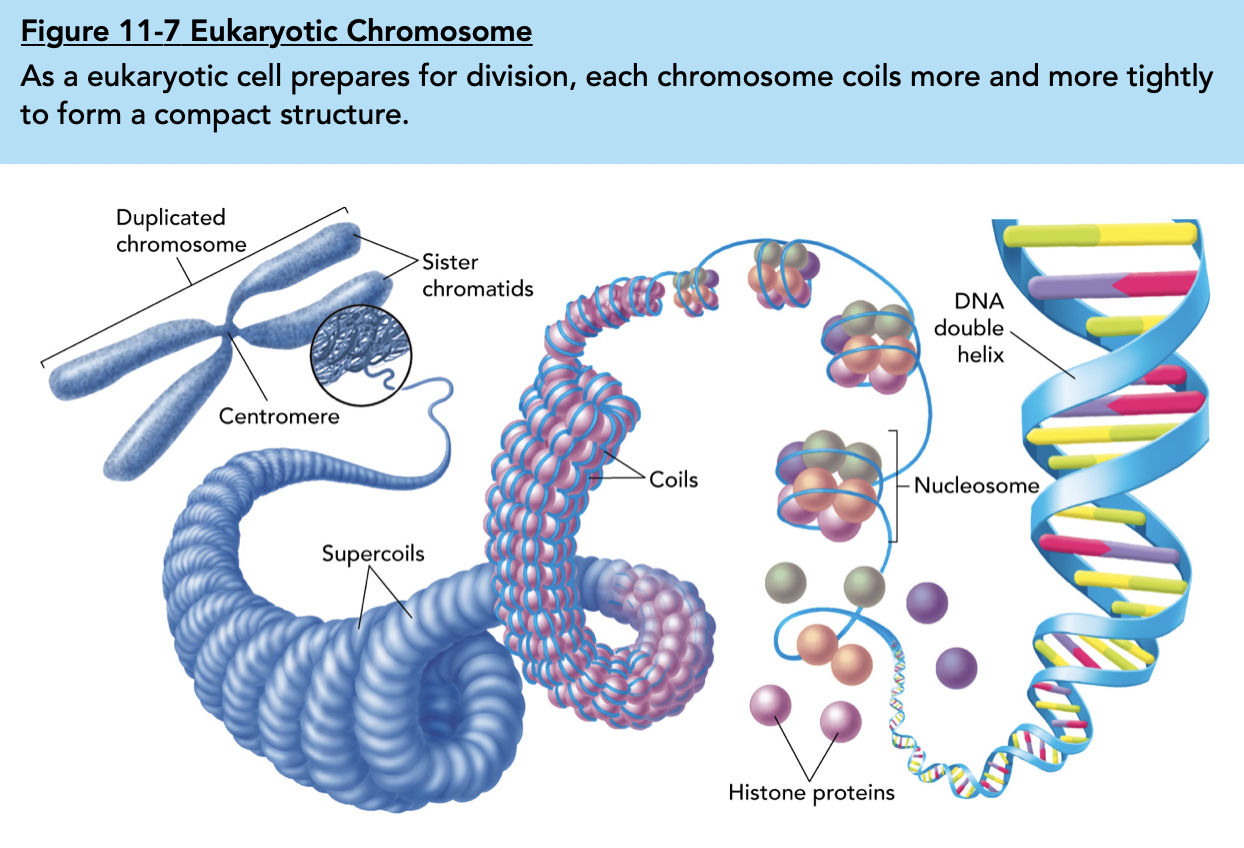
As you can see in the picture above, histone proteins are wrapped by DNA to form beadlike structures called nucleosomes.
Cell division is part of a series of events referred to as the cell cycle, where cells grow, prepare for division, and then divide to form two daughter cells.
Prokaryotic Cell Cycle:
 Eukaryotic Cell Cycle:
Eukaryotic Cell Cycle:
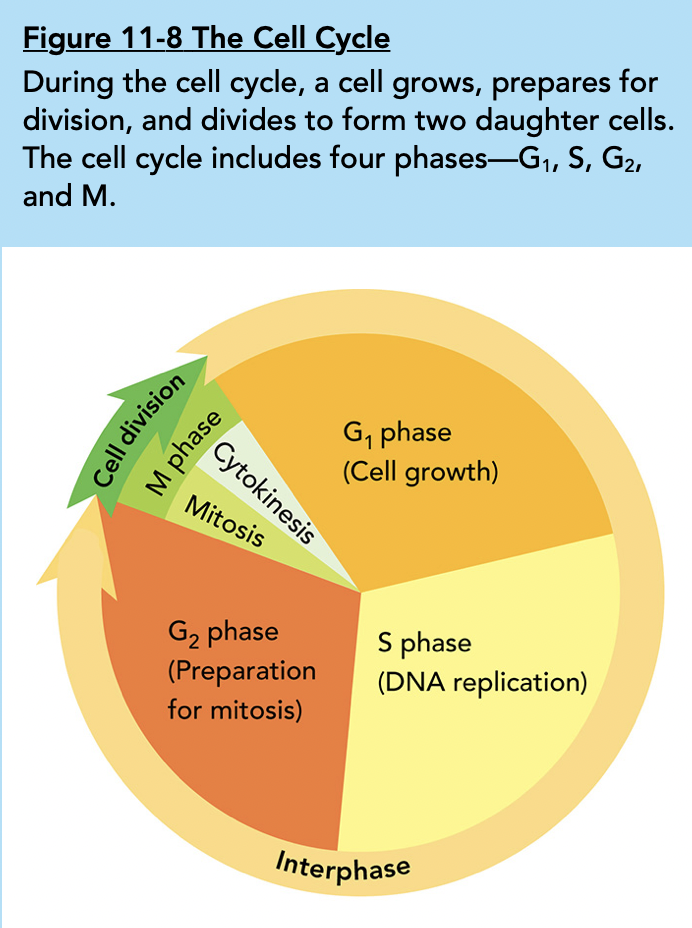
G1 phase: Cells increase in size, and new proteins/organelles are synthesized
S phase: Chromosomes are replicated, while new DNA is synthesized. At the end of this phase, there is twice as much DNA as there was in the beginning.

G2 phase: The shortest phase. Many of the organelles/proteins needed for cell division are produced
M phase: Stands for mitosis, the two new cells are produced in this stage.
After this, the next step begins where the cytoplasm is divided, called cytokinesis. This process can being while mitosis is ongoing.
Prophase
✩First stage of mitosis, and typically the longest (takes up half of the time to complete mitosis)
✩Genetic material condenses, and replicate chromosomes become visible. A spindle also starts to form to help separate chromosomes.
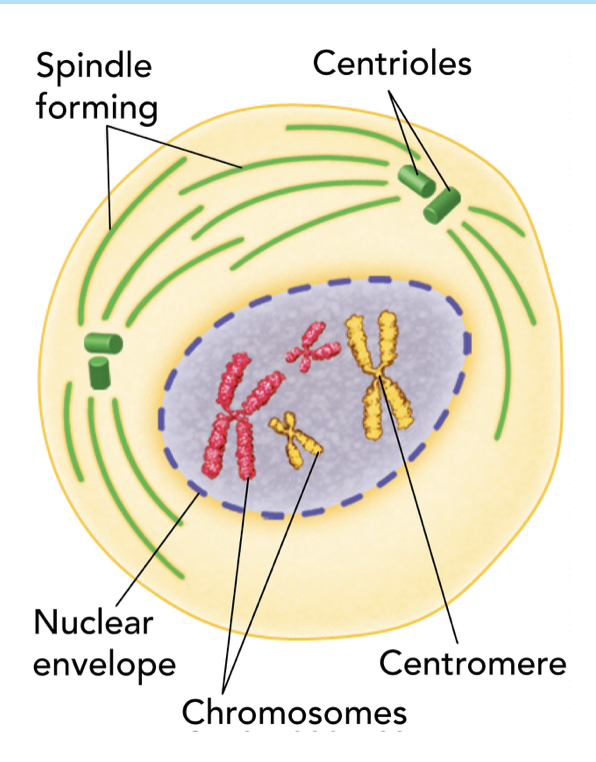
Metaphase
✩Usually the shortest phase
✩Centromeres of chromosomes line up in the center of the cell and the spindle fibers attach
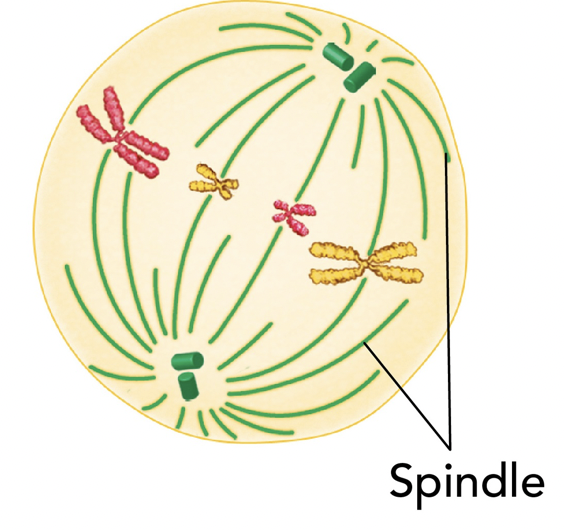
Anaphase
✩The chromatids separate, beginning to move apart along spindle fibers(Each chromatid is now considered a chromosome)
✩Microtubules that make up the mitotic spindle (spindle fibers) rapidly disassemble

Telophase
✩Last phase of mitosis(but cell division is not yet complete) where distinct and condensed chromosomes spread out.
✩The nuclear envelope reforms and the nucleolus becomes visible

Cytokinesis (Sometimes considered the 6th phase of mitosis)
✩The final step for the M phase to be complete is cytokinesis, where the cytoplasm divides and forms two separate cells.
✩This normally occurs while telophase is ongoing, and varies with plant and animal cells.
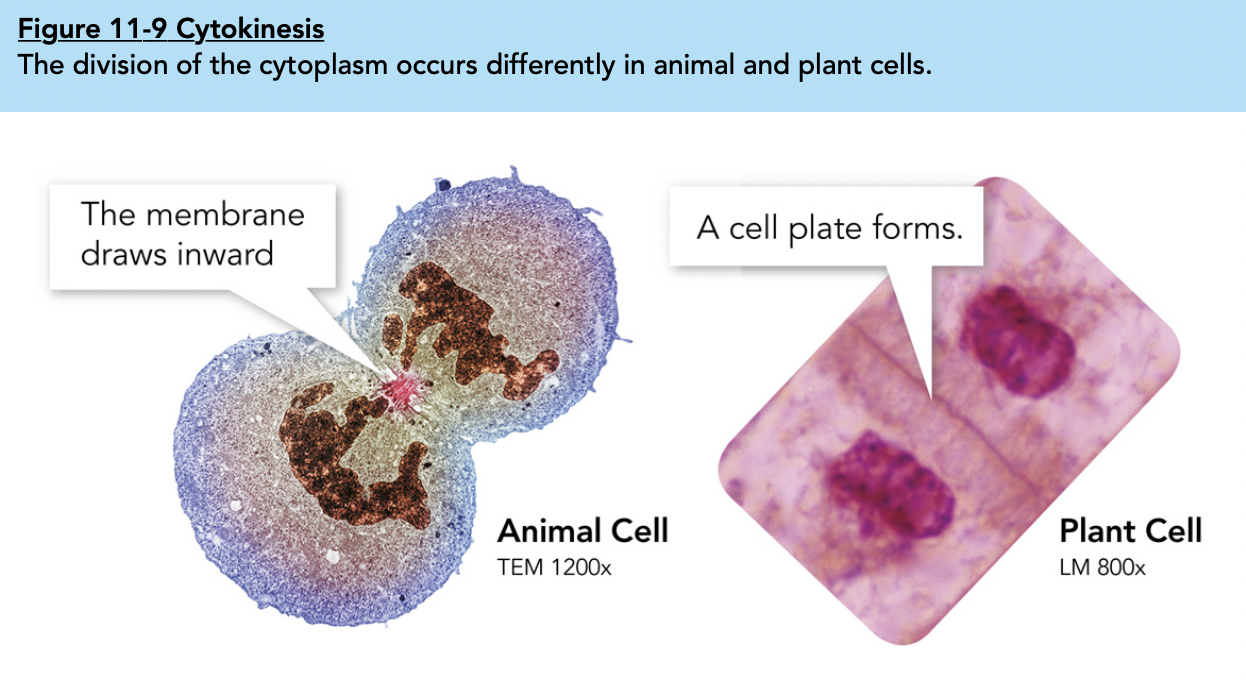
Summary of the phases of mitosis
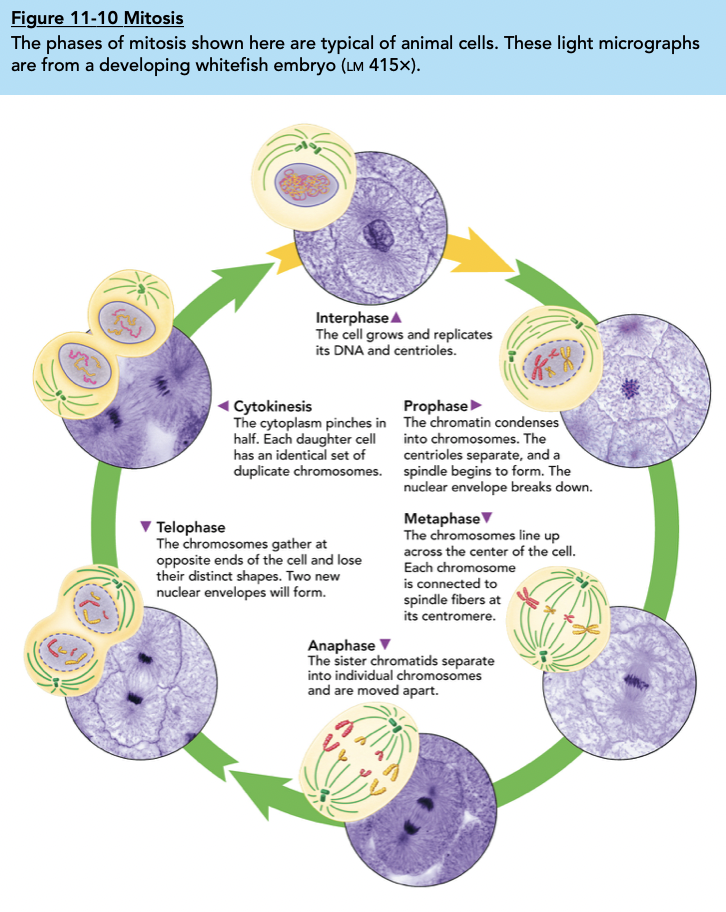
11.3 Regulating the Cell Cycle
The cell cycle is strictly controlled to reduce the chances of serious illnesses (such as cancer). One factor of this is contact inhibition.
Contact inhibition: cells can stop dividing once they come into contact, preventing tumors from developing (not all tumors are cancerous).
One example is how cells are stimulated to divide rapidly when a bone breaks to start the process of healing.
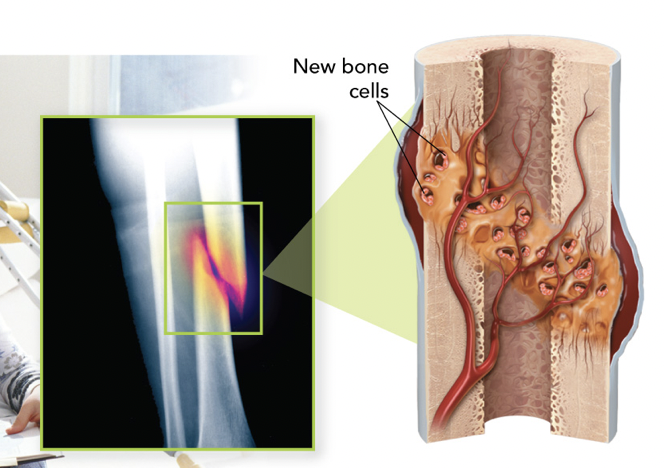
Regulatory proteins are signals that “tell” the cell when to divide, duplicate chromosomes, or enter another phase.
Internal Regulators:
-respond to events inside the cell
-lets the cell cycle proceed only when certain steps have already happened (checkpoints)
External regulators:
-respond to events outside of the cell
-directs cells to speed up or slow down the cell cycle
-prevents excessive cell growth and tissues from disrupting one another
The Discovery of Cyclins
Basic definition: proteins that regulate the cell
Cyclins build up to check if the DNA is replicated correctly. If not, the cell enters a pause phase to try and fix the error. They work with Cell-dependent Kinases (CDKs) to maintain control of the cycle. These are enzymes within the cytoplasm, which are activated by the cyclin build up. They help promote spindle formation, chromosome condensation, and help break down the nuclear envelope.
When cyclins are injected into a non-dividing cell, a mitotic spindle starts to form, leading scientists to this that this kind of protein (a whole class of proteins) regulates or triggers different parts of the cell cycle.
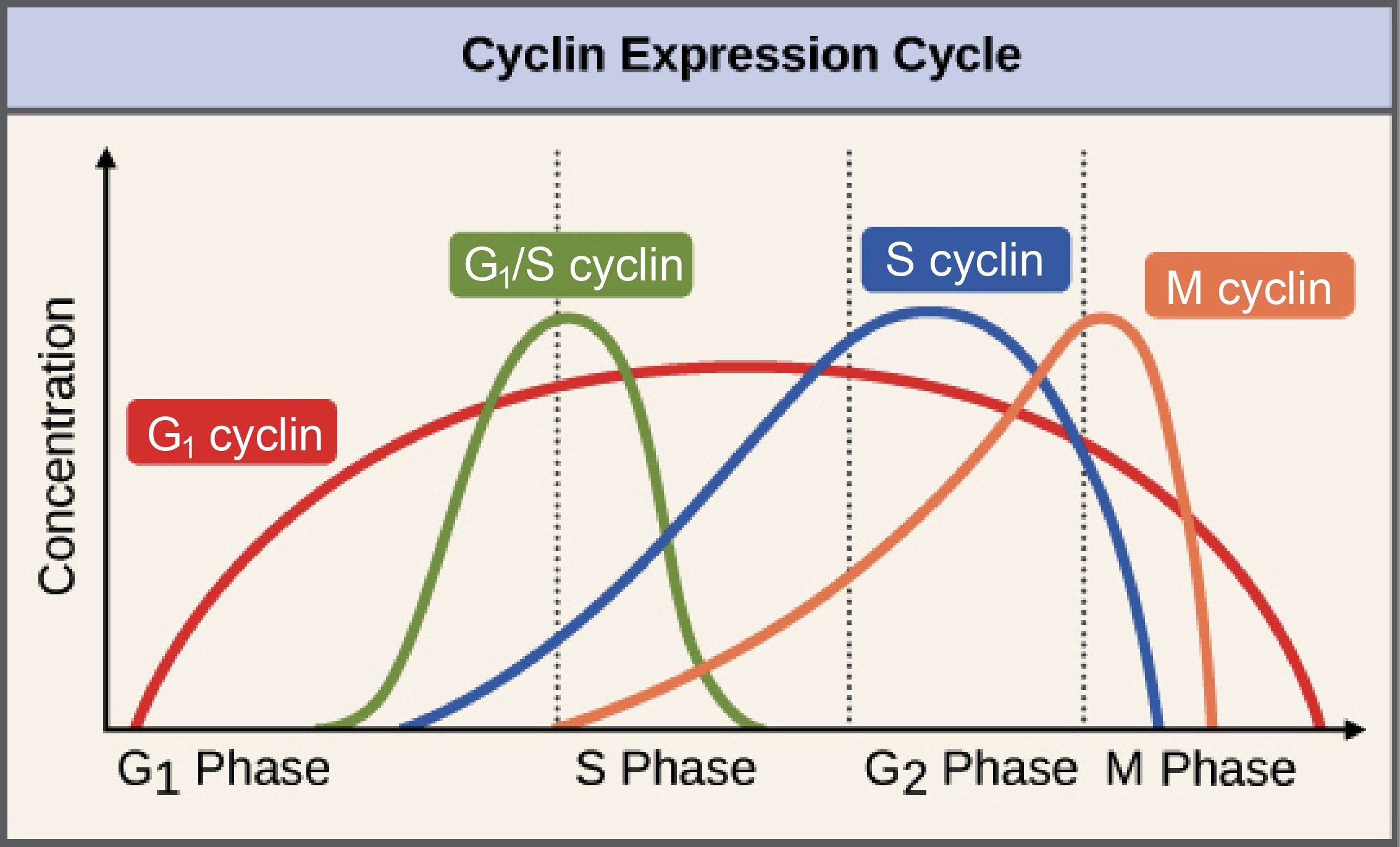
Three major cyclin checkpoints are:
G1:
Located at the end of G1 but at the start of S, this checkpoint ensures that the cells have grown properly. If not, they will enter a "pause" phase.
S:
In this checkpoint, any issues that relate to DNA replication trigger a "checkpoint"
M:
this checkpoint occurs at metaphase, and monitors if the sister chromatids have been attached correctly to the spindle microtubules.
Apoptosis
If something goes wrong at the checkpoint, the process of programmed cell death could occur. This is to keep mistakes from replicating.
-Cell undergoes a series of controlled steps for self-destruction
-An important role in structure tissues: certain cells may have to die to create certain forms
Example: On your hands, the cells between your fingers have to die for you not to get webbed fingers
Cancer: Uncontrolled Cell Growth (when apoptosis doesn’t work)
-Cancer cells don’t respond to normal regulator signals
-The cell cycle is disrupted
-Cells grow and divide uncontrollably
What makes this dangerous is that a cancerous tumor can metastasize, so it can break off and get transported throughout the body. Wherever it sticks, another tumor will form.

In all cancers, control over the cell cycle has broken down. Cancer results from a defect in genes that control cell growth and division.
Treatments for Cancer:
Surgery to remove localized tumors
Chemotherapy kills cancer cells or slows their growth since radiation destroys cancer cell DNA, but it can also destroy normal healthy cells
11.4 Cell Differentiation
During the development of a multicellular organism, cells differentiate to become specialized for particular functions. For example, a plant can grow to have leaf tissues and root tissues, specialized tissues it needs to survive as a multicellular organism.

So how did all these specialized cells form from just one cell, a fertilized egg(zygote)? Well, there are various kinds of cells that can form different cell types, the zygote being a totipotent cell. These various categories are referred to as stem cells.
Stem cells are the unspecialized cells from which differentiated cells developed
Totipotent: can develop into any type of cell in the body (including the cells that make up the extraembryonic membranes and placenta)
Pluripotent: cells that are capable of developing most, but not all, of the body’s cell types (cannot form the tissues surrounding the embryo)
Multipotent: the limited potential to develop into many different types of differentiated cells. Usually limited to replacing the cells in the tissues where they are found(mainly found in bone marrow, hair follicles. Also some in the brain, heart, and skeletal muscle).
Example: In human development, the human embryo forms into a blastocyst(filled with pluripotent cells inside) at one point, a hollow ball with clustered cells inside. They will begin to specialize.
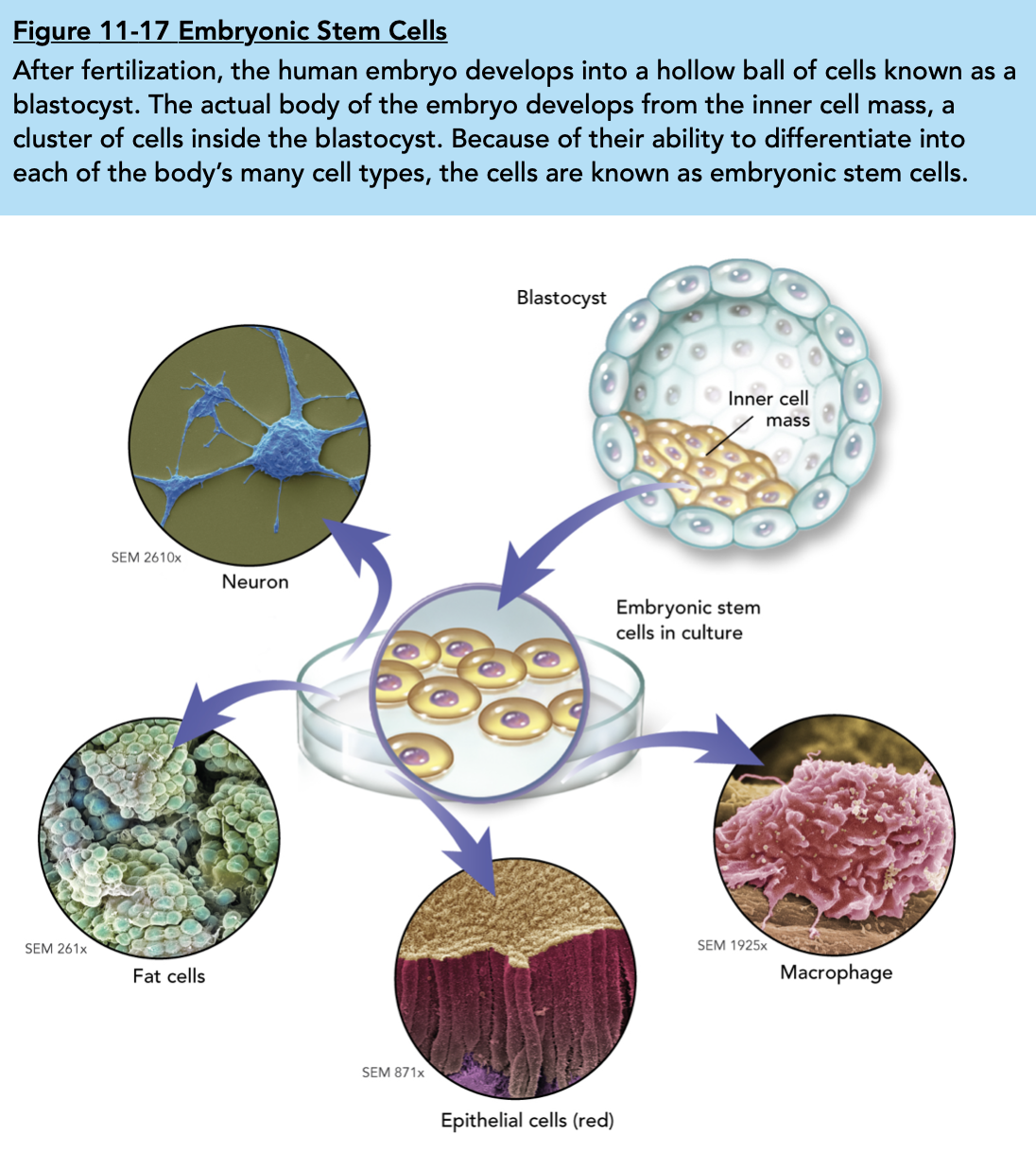
Ethical issues
Human adult stem cell research Is rarely controversial because of willing donors
Human embryonic stem cell research is controversial because arguments for and against involve issues of life and death
Chapter 11: Cell Growth and Division >
11.1 Cell Growth, Division, and Reproduction
An organism grows not because its cells increase in size, but because its cells grow and divide. Two reasons for this are that larger cells are less efficient in moving nutrients/waste materials and require more DNA.

Imagine if these cubes were cells. As the cells grow larger, the volume (amount of space in the object) grows more than the surface area (amount of "covering" on the object), which is an issue because the decrease of the relative cell membrane can create problems.

If a cell gets too large, it would be harder for it to get oxygen/nutrients in, and waste products out, similar to a traffic jam. The cell would also get bigger while its DNA stays the same, meaning that its DNA may not be sufficient (information overload: the larger the cell, the more demands it places on its DNA).
Therefore, it is better to split into two cells and duplicate the DNA so that both of the new cells can use them. This is called cell division, a process in which a cell is divided into two, and the DNA is replicated or divided. The problem of information overload is solved, and cell volume is also reduced, making the cells more efficient in the transportation of materials. Cell division is also asexual reproduction, which is the only form of reproduction for many single-celled organisms.
Asexual Reproduction: The production of genetically identical offspring from a single parent
Pros-
✩Quick reproduction if conditions are right, which is good for competition
✩More offspring in a short period
✩No need for another mate
Con-
✩Lacks genetic diversity, and cannot adapt to unfit conditions

Sexual Reproduction: The fusion of two reproductive cells formed by each of the two parents. Offspring produced by sexual reproduction inherit some of their genetic information from each parent
(most plants and animals reproduce this way, as well as many single-celled organisms).
Pros-
✩Advantage to species with changing environments or seasons: species can adapt by ensuring that a population contains the right characteristics to boost survivability.
Cons-
✩Requires more time
✩Needs to find a mate 
11.2 The Process of Cell Division
Cell division is constantly occurring in living beings, even when we stop growing. Whether you get a cut or fracture a bone, cell division keeps us in good condition by replacing worn cells and regenerating lost tissue.
A cell cannot simply split into two without preparation, especially because the genetic information needs two copies before cell division starts.
Cells have plenty of genetic information in the form of DNA carried by chromosomes, which is a structure within the nucleus.
In prokaryotic cells, DNA is packaged into a single, circular chromosome. In eukaryotic cells, DNA is packaged into multiple chromosomes and is more complex with multiple components.

As you can see in the picture above, histone proteins are wrapped by DNA to form beadlike structures called nucleosomes.
Cell division is part of a series of events referred to as the cell cycle, where cells grow, prepare for division, and then divide to form two daughter cells.
Prokaryotic Cell Cycle:
 Eukaryotic Cell Cycle:
Eukaryotic Cell Cycle:

G1 phase: Cells increase in size, and new proteins/organelles are synthesized
S phase: Chromosomes are replicated, while new DNA is synthesized. At the end of this phase, there is twice as much DNA as there was in the beginning.

G2 phase: The shortest phase. Many of the organelles/proteins needed for cell division are produced
M phase: Stands for mitosis, the two new cells are produced in this stage.
After this, the next step begins where the cytoplasm is divided, called cytokinesis. This process can being while mitosis is ongoing.
Prophase
✩First stage of mitosis, and typically the longest (takes up half of the time to complete mitosis)
✩Genetic material condenses, and replicate chromosomes become visible. A spindle also starts to form to help separate chromosomes.

Metaphase
✩Usually the shortest phase
✩Centromeres of chromosomes line up in the center of the cell and the spindle fibers attach

Anaphase
✩The chromatids separate, beginning to move apart along spindle fibers(Each chromatid is now considered a chromosome)
✩Microtubules that make up the mitotic spindle (spindle fibers) rapidly disassemble

Telophase
✩Last phase of mitosis(but cell division is not yet complete) where distinct and condensed chromosomes spread out.
✩The nuclear envelope reforms and the nucleolus becomes visible

Cytokinesis (Sometimes considered the 6th phase of mitosis)
✩The final step for the M phase to be complete is cytokinesis, where the cytoplasm divides and forms two separate cells.
✩This normally occurs while telophase is ongoing, and varies with plant and animal cells.

Summary of the phases of mitosis

11.3 Regulating the Cell Cycle
The cell cycle is strictly controlled to reduce the chances of serious illnesses (such as cancer). One factor of this is contact inhibition.
Contact inhibition: cells can stop dividing once they come into contact, preventing tumors from developing (not all tumors are cancerous).
One example is how cells are stimulated to divide rapidly when a bone breaks to start the process of healing.

Regulatory proteins are signals that “tell” the cell when to divide, duplicate chromosomes, or enter another phase.
Internal Regulators:
-respond to events inside the cell
-lets the cell cycle proceed only when certain steps have already happened (checkpoints)
External regulators:
-respond to events outside of the cell
-directs cells to speed up or slow down the cell cycle
-prevents excessive cell growth and tissues from disrupting one another
The Discovery of Cyclins
Basic definition: proteins that regulate the cell
Cyclins build up to check if the DNA is replicated correctly. If not, the cell enters a pause phase to try and fix the error. They work with Cell-dependent Kinases (CDKs) to maintain control of the cycle. These are enzymes within the cytoplasm, which are activated by the cyclin build up. They help promote spindle formation, chromosome condensation, and help break down the nuclear envelope.
When cyclins are injected into a non-dividing cell, a mitotic spindle starts to form, leading scientists to this that this kind of protein (a whole class of proteins) regulates or triggers different parts of the cell cycle.

Three major cyclin checkpoints are:
G1:
Located at the end of G1 but at the start of S, this checkpoint ensures that the cells have grown properly. If not, they will enter a "pause" phase.
S:
In this checkpoint, any issues that relate to DNA replication trigger a "checkpoint"
M:
this checkpoint occurs at metaphase, and monitors if the sister chromatids have been attached correctly to the spindle microtubules.
Apoptosis
If something goes wrong at the checkpoint, the process of programmed cell death could occur. This is to keep mistakes from replicating.
-Cell undergoes a series of controlled steps for self-destruction
-An important role in structure tissues: certain cells may have to die to create certain forms
Example: On your hands, the cells between your fingers have to die for you not to get webbed fingers
Cancer: Uncontrolled Cell Growth (when apoptosis doesn’t work)
-Cancer cells don’t respond to normal regulator signals
-The cell cycle is disrupted
-Cells grow and divide uncontrollably
What makes this dangerous is that a cancerous tumor can metastasize, so it can break off and get transported throughout the body. Wherever it sticks, another tumor will form.

In all cancers, control over the cell cycle has broken down. Cancer results from a defect in genes that control cell growth and division.
Treatments for Cancer:
Surgery to remove localized tumors
Chemotherapy kills cancer cells or slows their growth since radiation destroys cancer cell DNA, but it can also destroy normal healthy cells
11.4 Cell Differentiation
During the development of a multicellular organism, cells differentiate to become specialized for particular functions. For example, a plant can grow to have leaf tissues and root tissues, specialized tissues it needs to survive as a multicellular organism.

So how did all these specialized cells form from just one cell, a fertilized egg(zygote)? Well, there are various kinds of cells that can form different cell types, the zygote being a totipotent cell. These various categories are referred to as stem cells.
Stem cells are the unspecialized cells from which differentiated cells developed
Totipotent: can develop into any type of cell in the body (including the cells that make up the extraembryonic membranes and placenta)
Pluripotent: cells that are capable of developing most, but not all, of the body’s cell types (cannot form the tissues surrounding the embryo)
Multipotent: the limited potential to develop into many different types of differentiated cells. Usually limited to replacing the cells in the tissues where they are found(mainly found in bone marrow, hair follicles. Also some in the brain, heart, and skeletal muscle).
Example: In human development, the human embryo forms into a blastocyst(filled with pluripotent cells inside) at one point, a hollow ball with clustered cells inside. They will begin to specialize.

Ethical issues
Human adult stem cell research Is rarely controversial because of willing donors
Human embryonic stem cell research is controversial because arguments for and against involve issues of life and death
 Knowt
Knowt